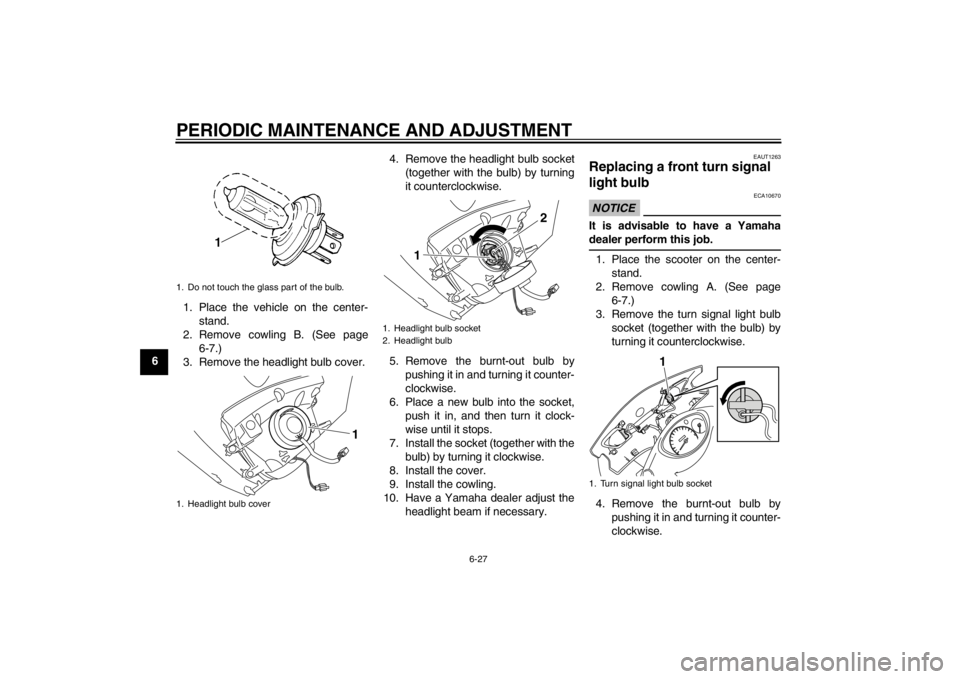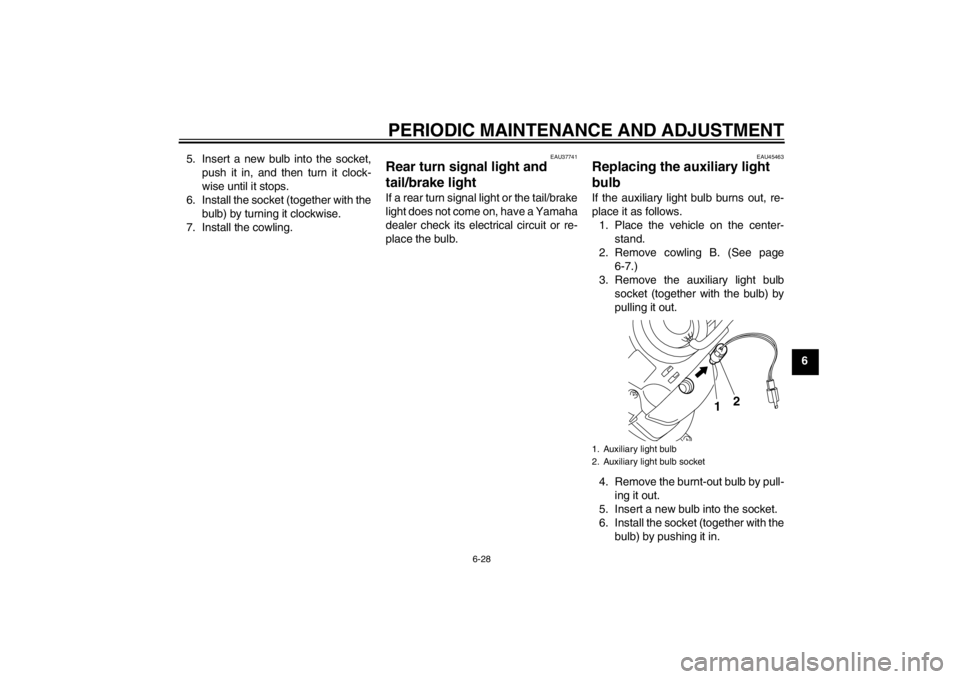turn signal YAMAHA CYGNUS L 2012 Owners Manual
[x] Cancel search | Manufacturer: YAMAHA, Model Year: 2012, Model line: CYGNUS L, Model: YAMAHA CYGNUS L 2012Pages: 76, PDF Size: 1.56 MB
Page 6 of 76

TABLE OF CONTENTSSAFETY INFORMATION ..................1-1
Further safe-riding points ................1-5
DESCRIPTION ..................................2-1
Left view ..........................................2-1
Right view ........................................2-2
Controls and instruments.................2-3
INSTRUMENT AND CONTROL
FUNCTIONS.......................................3-1
Main switch/steering lock ................3-1
Keyhole cover .................................3-2
Indicator lights and warning light ....3-2
Speedometer unit ...........................3-3
Self-diagnosis device ......................3-3
Fuel gauge ......................................3-4
Handlebar switches ........................3-4
Front brake lever ............................3-5
Rear brake lever .............................3-5
Fuel tank cap ..................................3-5
Fuel .................................................3-6
Catalytic converters ........................3-7
Kickstarter .......................................3-8
Seat ................................................3-8
Helmet holders ...............................3-9
Storage compartments ...................3-9
Carrier ...........................................3-11
Luggage hook ...............................3-11
Grab bar .......................................3-11
Sidestand ......................................3-12
Ignition circuit cut-off system ........3-12FOR YOUR SAFETY –
PRE-OPERATION CHECKS............. 4-1
OPERATION AND IMPORTANT
RIDING POINTS................................. 5-1
Starting the engine ......................... 5-1
Starting off ...................................... 5-2
Acceleration and deceleration ........ 5-2
Braking ........................................... 5-2
Tips for reducing fuel
consumption ............................... 5-3
Engine break-in .............................. 5-3
Parking ........................................... 5-4
PERIODIC MAINTENANCE AND
ADJUSTMENT................................... 6-1
Periodic maintenance chart for
the emission control system ....... 6-3
General maintenance and
lubrication chart .......................... 6-4
Removing and installing cowlings
and panels .................................. 6-7
Checking the spark plug ................. 6-9
Engine oil ..................................... 6-10
Final transmission oil .................... 6-12
Air filter and V-belt case air filter
elements ................................... 6-13
Checking the engine idling
speed ........................................ 6-15
Checking the throttle grip free
play ........................................... 6-15Valve clearance ........................... 6-15
Tires ............................................. 6-16
Cast wheels ................................. 6-17
Checking the front brake lever
free play .................................... 6-18
Adjusting the rear brake lever
free play .................................... 6-18
Checking the front brake pads
and rear brake shoes ............... 6-19
Checking the brake fluid level ...... 6-20
Changing the brake fluid .............. 6-21
Checking and lubricating
the cables ................................. 6-21
Checking and lubricating
the throttle grip and cable ......... 6-21
Lubricating the front and
rear brake levers ...................... 6-22
Checking and lubricating the
centerstand and sidestand ....... 6-22
Checking the front fork ................. 6-23
Checking the steering .................. 6-24
Checking the wheel bearings ....... 6-24
Battery ......................................... 6-24
Replacing the fuse ....................... 6-26
Replacing the headlight bulb ....... 6-26
Replacing a front turn signal
light bulb ................................... 6-27
Rear turn signal light and
tail/brake light ........................... 6-28
Replacing the auxiliary light
bulb ........................................... 6-28U1RSE0E0.book Page 1 Tuesday, October 18, 2011 8:56 AM
Page 9 of 76

SAFETY INFORMATION
1-2
1 cessive speed or undercornering
(insufficient lean angle for the
speed).
Always obey the speed limit and
never travel faster than warrant-
ed by road and traffic conditions.
Always signal before turning or
changing lanes. Make sure that
other motorists can see you.
●
The posture of the operator and
passenger is important for proper
control.
The operator should keep both
hands on the handlebar and
both feet on the operator foot-
rests during operation to main-
tain control of the scooter.
The passenger should always
hold onto the operator, the seat
strap or grab bar, if equipped,
with both hands and keep both
feet on the passenger footrests.
Never carry a passenger unless
he or she can firmly place both
feet on the passenger footrests.
●
Never ride under the influence of
alcohol or other drugs.
●
This scooter is designed for on-
road use only. It is not suitable for
off-road use.
Protective Apparel
The majority of fatalities from scooter
accidents are the result of head inju-
ries. The use of a safety helmet is the
single most critical factor in the preven-
tion or reduction of head injuries.
●
Always wear an approved helmet.
●
Wear a face shield or goggles.
Wind in your unprotected eyes
could contribute to an impairment
of vision that could delay seeing a
hazard.
●
The use of a jacket, substantial
shoes, trousers, gloves, etc., is ef-
fective in preventing or reducing
abrasions or lacerations.
●
Never wear loose-fitting clothes,
otherwise they could catch on the
control levers or wheels and cause
injury or an accident.
●
Always wear protective clothing
that covers your legs, ankles, and
feet. The engine or exhaust sys-
tem become very hot during or af-
ter operation and can cause burns.
●
A passenger should also observe
the above precautions.
Avoid Carbon Monoxide Poisoning
All engine exhaust contains carbon
monoxide, a deadly gas. Breathing car-
bon monoxide can cause headaches,
dizziness, drowsiness, nausea, confu-
sion, and eventually death.
Carbon Monoxide is a colorless, odor-
less, tasteless gas which may be
present even if you do not see or smell
any engine exhaust. Deadly levels of
carbon monoxide can collect rapidly
and you can quickly be overcome and
unable to save yourself. Also, deadly
levels of carbon monoxide can linger
for hours or days in enclosed or poorly
ventilated areas. If you experience any
symptoms of carbon monoxide poison-
ing, leave the area immediately, get
fresh air, and SEEK MEDICAL TREAT-
MENT.
●
Do not run engine indoors. Even if
you try to ventilate engine exhaust
with fans or open windows and
doors, carbon monoxide can rap-
idly reach dangerous levels.
U1RSE0E0.book Page 2 Tuesday, October 18, 2011 8:56 AM
Page 12 of 76

SAFETY INFORMATION
1-5
1
●
Point the front wheel straight
ahead on the trailer or in the truck
bed, and choke it in a rail to pre-
vent movement.
●
Secure the scooter with tie-downs
or suitable straps that are attached
to solid parts of the scooter, such
as the frame or upper front fork tri-
ple clamp (and not, for example, to
rubber-mounted handlebars or
turn signals, or parts that could
break). Choose the location for the
straps carefully so the straps will
not rub against painted surfaces
during transport.
●
The suspension should be com-
pressed somewhat by the tie-
downs, if possible, so that the
scooter will not bounce excessive-
ly during transport.
EAU45371
Further safe-riding points ●
Make sure to signal clearly when
making turns.
Left turn
Right turn
●
Braking can be extremely difficult
on a wet road. Avoid hard braking,
because the scooter could slide.
Apply the brakes slowly when
stopping on a wet surface.
●
Slow down as you approach a cor-
ner or turn. Once you have com-
pleted a turn, accelerate slowly.
●
Be careful when passing parked
cars. A driver might not see you
and open a door in your path.
●
Railroad crossings, streetcar rails,
iron plates on road construction
sites, and manhole covers be-
come extremely slippery when
wet. Slow down and cross them
with caution. Keep the scooter up-
right, otherwise it could slide out
from under you.
●
The brake pads and linings could
get wet when you wash the scoot-
er. After washing the scooter,
check the brakes before riding.
●
Always wear a helmet, gloves,
trousers (tapered around the cuff
and ankle so they do not flap), and
a bright colored jacket.
U1RSE0E0.book Page 5 Tuesday, October 18, 2011 8:56 AM
Page 18 of 76

INSTRUMENT AND CONTROL FUNCTIONS
3-2
3To unlock the steering and the center-
standPush the key in, and then turn it to
“OFF” while still pushing it.
EAUT2121
Keyhole cover To close the keyhole cover
Insert the key bow into the keyhole cov-
er receptacle as shown, and then turn
the key to “SHUT” to close the cover.
To open the keyhole cover
Insert the key bow into the keyhole cov-
er receptacle as shown, and then turn
the key to “OPEN” to open the cover.
EAU11006
Indicator lights and warning
light
EAU11020
Turn signal indicator light “ ”
This indicator light flashes when the
turn signal switch is pushed to the left or
right.
EAU11080
High beam indicator light “ ”
This indicator light comes on when the
high beam of the headlight is switched
on.
1. Push.
2. Turn.12
ON
OPEN
OPENPUSH
LOCK
OFF
1. Engine trouble warning light “ ”
2. High beam indicator light “ ”
3. Turn signal indicator light “ ”
123
U1RSE0E0.book Page 2 Tuesday, October 18, 2011 8:56 AM
Page 20 of 76

INSTRUMENT AND CONTROL FUNCTIONS
3-4
3
EAU45630
Fuel gauge The fuel gauge indicates the amount of
fuel in the fuel tank. The needle moves
towards “E” (Empty) as the fuel level
decreases. When the needle reaches
the red line, refuel as soon as possible.TIPTurning the key to “OFF” cancels the
fuel gauge reading.
EAU1234A
Handlebar switches Left
Right
EAU12400
Dimmer switch “ / ”
Set this switch to “ ” for the high
beam and to “ ” for the low beam.
EAU12460
Turn signal switch “ / ”
To signal a right-hand turn, push this
switch to “ ”. To signal a left-hand
turn, push this switch to “ ”. When re-
leased, the switch returns to the center
position. To cancel the turn signal
lights, push the switch in after it has re-
turned to the center position.
EAU12500
Horn switch “ ”
Press this switch to sound the horn.
EAU12721
Start switch “ ”
With the sidestand up, push this switch
while applying the front or rear brake to
crank the engine with the starter. See
page 5-1 for starting instructions prior
to starting the engine.
1. Fuel gauge
2. Red line
1
2
1. Dimmer switch “ / ”
2. Turn signal switch “ / ”
3. Horn switch “ ”
1. Start switch “ ”
2 13
1
U1RSE0E0.book Page 4 Tuesday, October 18, 2011 8:56 AM
Page 33 of 76

OPERATION AND IMPORTANT RIDING POINTS
5-2
5
EAU16761
Starting off TIPBefore starting off, allow the engine to
warm up.1. While pulling the rear brake lever
with your left hand and holding the
grab bar with your right hand, push
the scooter off the centerstand.
2. Sit astride the seat, and then ad-
just the rear view mirrors.
3. Switch the turn signals on.
4. Check for oncoming traffic, and
then slowly turn the throttle grip (on
the right) in order to take off.
5. Switch the turn signals off.
EAU16780
Acceleration and deceleration The speed can be adjusted by opening
and closing the throttle. To increase the
speed, turn the throttle grip in direction
(a). To reduce the speed, turn the throt-
tle grip in direction (b).
EAU16793
Braking
WARNING
EWA10300
●
Avoid braking hard or suddenly
(especially when leaning over to
one side), otherwise the scooter
may skid or overturn.
●
Railroad crossings, streetcar
rails, iron plates on road con-
struction sites, and manhole
covers become extremely slip-
pery when wet. Therefore, slow
down when approaching such
areas and cross them with cau-
tion.
●
Keep in mind that braking on a
wet road is much more difficult.
●
Ride slowly down a hill, as brak-
ing downhill can be very diffi-
cult.
1. Close the throttle completely.
2. Apply both front and rear brakes
simultaneously while gradually in-
creasing the pressure.
1. Grab bar
1
(b)
(a)
ZAUM0199
U1RSE0E0.book Page 2 Tuesday, October 18, 2011 8:56 AM
Page 62 of 76

PERIODIC MAINTENANCE AND ADJUSTMENT
6-27
61. Place the vehicle on the center-
stand.
2. Remove cowling B. (See page
6-7.)
3. Remove the headlight bulb cover.4. Remove the headlight bulb socket
(together with the bulb) by turning
it counterclockwise.
5. Remove the burnt-out bulb by
pushing it in and turning it counter-
clockwise.
6. Place a new bulb into the socket,
push it in, and then turn it clock-
wise until it stops.
7. Install the socket (together with the
bulb) by turning it clockwise.
8. Install the cover.
9. Install the cowling.
10. Have a Yamaha dealer adjust the
headlight beam if necessary.
EAUT1263
Replacing a front turn signal
light bulb NOTICE
ECA10670
It is advisable to have a Yamaha
dealer perform this job.1. Place the scooter on the center-
stand.
2. Remove cowling A. (See page
6-7.)
3. Remove the turn signal light bulb
socket (together with the bulb) by
turning it counterclockwise.
4. Remove the burnt-out bulb by
pushing it in and turning it counter-
clockwise.
1. Do not touch the glass part of the bulb.
1. Headlight bulb cover
1
1. Headlight bulb socket
2. Headlight bulb
2
1
1. Turn signal light bulb socket
1
U1RSE0E0.book Page 27 Tuesday, October 18, 2011 8:56 AM
Page 63 of 76

PERIODIC MAINTENANCE AND ADJUSTMENT
6-28
6 5. Insert a new bulb into the socket,
push it in, and then turn it clock-
wise until it stops.
6. Install the socket (together with the
bulb) by turning it clockwise.
7. Install the cowling.
EAU37741
Rear turn signal light and
tail/brake light If a rear turn signal light or the tail/brake
light does not come on, have a Yamaha
dealer check its electrical circuit or re-
place the bulb.
EAU45463
Replacing the auxiliary light
bulb If the auxiliary light bulb burns out, re-
place it as follows.
1. Place the vehicle on the center-
stand.
2. Remove cowling B. (See page
6-7.)
3. Remove the auxiliary light bulb
socket (together with the bulb) by
pulling it out.
4. Remove the burnt-out bulb by pull-
ing it out.
5. Insert a new bulb into the socket.
6. Install the socket (together with the
bulb) by pushing it in.1. Auxiliary light bulb
2. Auxiliary light bulb socket
12
U1RSE0E0.book Page 28 Tuesday, October 18, 2011 8:56 AM
Page 71 of 76

SPECIFICATIONS
8-2
8
Front tire:Type:
Tubeless
Size:
100/90-10 56J
Manufacturer/model:
CHENG SHIN/C-922-XRear tire:Type:
Tubeless
Size:
100/90-10 56J
Manufacturer/model:
CHENG SHIN/C-940-XLoading:Maximum load:
165 kg (364 lb)
(Total weight of rider, passenger, cargo and
accessories)Tire air pressure (measured on cold
tires):Loading condition:
0–75 kg (0–165 lb)
Front:
175 kPa (1.75 kgf/cm², 25 psi)
Rear:
250 kPa (2.50 kgf/cm², 36 psi)
Loading condition:
75–153 kg (165–337 lb)
Front:
175 kPa (1.75 kgf/cm², 25 psi)
Rear:
250 kPa (2.50 kgf/cm², 36 psi)
Front wheel:Wheel type:
Cast wheel
Rim size:
J10 x MT2.15Rear wheel:Wheel type:
Cast wheel
Rim size:
J10 x MT2.50Front brake:Type:
Single disc brake
Operation:
Right hand operation
Specified brake fluid:
DOT 3 or 4Rear brake:Type:
Drum brake
Operation:
Left hand operationFront suspension:Type:
Telescopic fork
Spring/shock absorber type:
Coil spring/oil damper
Wheel travel:
80.0 mm (3.15 in)Rear suspension:Type:
Unit swing
Spring/shock absorber type:
Coil spring/oil damperWheel travel:
63.0 mm (2.48 in)
Electrical system:Ignition system:
DC CDI
Charging system:
AC magnetoBattery:Model:
YTX7A-BS
Voltage, capacity:
12 V, 6.0 AhHeadlight:Bulb type:
IncandescenceBulb voltage, wattage × quantity:Headlight:
12 V, 35 W/35 W × 1
Tail/brake light:
12 V, 5.0 W/21.0 W × 1
Front turn signal light:
12 V, 10.0 W × 2
Rear turn signal light:
12 V, 16.0 W × 2
Auxiliary light:
12 V, 3.0 W × 1
Meter lighting:
12 V, 3.4 W × 2
High beam indicator light:
12 V, 1.7 W × 1
Turn signal indicator light:
12 V, 1.7 W × 1
Engine trouble warning light:
12 V, 3.4 W × 1
U1RSE0E0.book Page 2 Tuesday, October 18, 2011 8:56 AM
Page 74 of 76

INDEXAAcceleration and deceleration................. 5-2
Air filter and V-belt case air filter
elements ............................................. 6-13
Auxiliary light bulb, replacing ................ 6-28BBattery................................................... 6-24
Brake fluid, changing ............................ 6-21
Brake fluid level, checking .................... 6-20
Brake lever, front..................................... 3-5
Brake lever, rear ..................................... 3-5
Brake levers, lubricating........................ 6-22
Brake pads and shoes, checking .......... 6-19
Braking .................................................... 5-2CCables, checking and lubricating .......... 6-21
Care ........................................................ 7-1
Carrier ................................................... 3-11
Catalytic converters ................................ 3-7
Centerstand and sidestand,
checking and lubricating ..................... 6-22
Cowlings and panels,
removing and installing ......................... 6-7DDimmer switch ........................................ 3-4EEngine break-in ....................................... 5-3
Engine idling speed, checking .............. 6-15
Engine oil .............................................. 6-10
Engine serial number .............................. 9-1
Engine trouble warning light.................... 3-3FFinal transmission oil ............................ 6-12
Frame serial number ............................... 9-1Front brake lever free play, checking ... 6-18
Front fork, checking .............................. 6-23
Fuel......................................................... 3-6
Fuel consumption, tips for reducing........ 5-3
Fuel gauge.............................................. 3-4
Fuel tank cap .......................................... 3-5
Fuse, replacing ..................................... 6-26
GGrab bar ............................................... 3-11HHandlebar switches ................................ 3-4
Headlight bulb, replacing ...................... 6-26
Helmet holders ....................................... 3-9
High beam indicator light ........................ 3-2
Horn switch ............................................. 3-4IIdentification numbers ............................ 9-1
Ignition circuit cut-off system ................ 3-12
Indicator lights and warning light ............ 3-2KKeyhole cover ......................................... 3-2
Kickstarter............................................... 3-8LLuggage hook ....................................... 3-11MMain switch/steering lock........................ 3-1
Maintenance and lubrication, periodic .... 6-4
Maintenance, emission control system... 6-3
Matte color, caution ................................ 7-1PParking ................................................... 5-4
Part locations .......................................... 2-1RRear brake lever free play, adjusting .... 6-18Rear turn signal light and
tail/brake light...................................... 6-28
SSafe-riding points .................................... 1-5
Safety information ................................... 1-1
Seat ......................................................... 3-8
Self-diagnosis device .............................. 3-3
Sidestand .............................................. 3-12
Spark plug, checking ............................... 6-9
Specifications .......................................... 8-1
Speedometer unit .................................... 3-3
Starting off ............................................... 5-2
Starting the engine .................................. 5-1
Start switch.............................................. 3-4
Steering, checking................................. 6-24
Storage.................................................... 7-3
Storage compartments ............................ 3-9TThrottle grip and cable,
checking and lubricating ..................... 6-21
Throttle grip free play, checking ............ 6-15
Tires ...................................................... 6-16
Troubleshooting .................................... 6-29
Troubleshooting chart ........................... 6-30
Turn signal indicator light ........................ 3-2
Turn signal light bulb (front),
replacing ............................................. 6-27
Turn signal switch ................................... 3-4VValve clearance..................................... 6-15WWheel bearings, checking ..................... 6-24
Wheels .................................................. 6-17
U1RSE0E0.book Page 1 Tuesday, October 18, 2011 8:56 AM